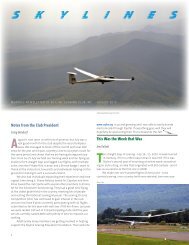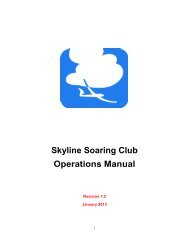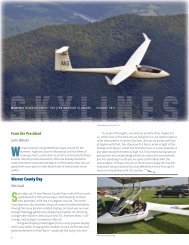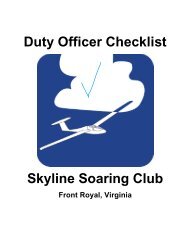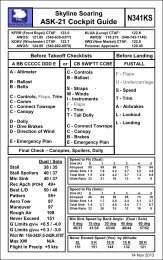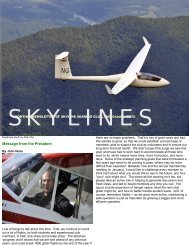Message from the President - Skyline Soaring Club
Message from the President - Skyline Soaring Club
Message from the President - Skyline Soaring Club
You also want an ePaper? Increase the reach of your titles
YUMPU automatically turns print PDFs into web optimized ePapers that Google loves.
Why did <strong>the</strong>se folks make <strong>the</strong> long journey for spin training Aren’t<br />
data to o<strong>the</strong>r instruments, PDAs, etc. Although not yet available,<br />
<strong>the</strong> PowerFLARM will also provide an IGC-approved flight logging<br />
facility, good for badges, OLC, etc.<br />
Installation<br />
I highly encourage as many glider pilots as possible to equip <strong>the</strong>ir<br />
aircraft with PowerFLARM units. They work best when everyone<br />
has <strong>the</strong>m, after all. While not a magic bullet, widespread<br />
installation of <strong>the</strong>se systems could make a significant impact on<br />
safety.<br />
There are two different versions of PowerFLARM available. One,<br />
<strong>the</strong> "brick" is intended to be permanently installed in an aircraft.<br />
The PowerFLARM smarts live in a fairly blank and boring box<br />
which you can stash anyhwere, and it comes with a separate<br />
display module that goes into your instrument panel.<br />
Installation of <strong>the</strong> brick is a bit tricky. It has three separate<br />
antennas (GPS, ADS-B/transponder, and FLARM) which all need<br />
to be positioned some distance away <strong>from</strong> each o<strong>the</strong>r. However,<br />
with a bit of creativity, plastic, and plenty of 3M Dual Lock, it's<br />
entirely doable and not overly difficult. Once installed, <strong>the</strong> system<br />
just does its thing without any manual intervention.<br />
A portable unit is also available. This unit contains everything<br />
necessary in one box, including batteries for internal power<br />
(although it will also accept external power if desired). This can be<br />
attached to <strong>the</strong> top of your glare shield or ano<strong>the</strong>r convenient<br />
location, and easily moved between aircraft if need be.<br />
Real-World Use<br />
We haven't had our PowerFLARM up and running for long, but I've<br />
had a chance to at least get an idea of how it works.<br />
Jim Garrison helped with our installation, and also brought his own<br />
PowerFLARM unit along. Once everything was installed, we fired<br />
up both units and <strong>the</strong>y showed up to each o<strong>the</strong>r just as promised.<br />
It wasn't practical to trigger collision warnings, but each unit<br />
showed <strong>the</strong> o<strong>the</strong>r's relative position and altitude just like it's<br />
supposed to. When a collision doesn't threaten, <strong>the</strong> unit simply<br />
displays <strong>the</strong> position of o<strong>the</strong>r traffic in an unobtrusive manner, for<br />
you to use or ignore as you wish.<br />
The system frequently alerts while sitting on <strong>the</strong> ground, just about<br />
any time a transponder-equipped airplane lands, including our own<br />
tow planes and <strong>the</strong> ASK-21. These false alarms would be<br />
annoying in flight, but are a good illustration of how <strong>the</strong> system<br />
works when sitting safely on <strong>the</strong> ground.<br />
PowerFLARM is available <strong>from</strong> many online glider equipment<br />
dealers. The cost is $1,695 for <strong>the</strong> portable unit or <strong>the</strong> brick with a<br />
rectangular external display, or $1,845 for <strong>the</strong> brick with a display<br />
that mounts in a 57mm instrument hole.<br />
Spinning on Purpose<br />
By Dan Earnst<br />
In <strong>the</strong> air, it works as advertised. I've yet to test <strong>the</strong> FLARM or<br />
ADS-B functionality while airborne, but <strong>the</strong> transponder detection<br />
works nicely, within <strong>the</strong> limitations of <strong>the</strong> technology. I've picked up<br />
<strong>the</strong> ASK-21 and some ohter light aircraft in <strong>the</strong> area. One<br />
interesting feature of <strong>the</strong> system is that it will display relative<br />
altitude of a transponder target even when it's not a collision<br />
threat, making it trivial to figure out just how much headroom you<br />
have above or below when <strong>the</strong>rmalling with ano<strong>the</strong>r (transponderequipped)<br />
glider at different altitudes. This taught me that I need<br />
some practice at estimating altitude differences, as I was<br />
<strong>the</strong>rmalling below <strong>the</strong> ASK-21 at an altitude difference of what I<br />
would have guessed was about 500ft, but <strong>the</strong> PowerFLARM<br />
assured me it was actually a 1,200ft difference.<br />
Conclusion<br />
PowerFLARM is exciting technology and its arrival in <strong>the</strong> US is<br />
most welcome. Mid-air collisions represent a significant risk for us,<br />
and one that can be tough to mitigate. The Mark-I Eyeball has<br />
many faults and is not entirely ideal as an anti-collision device.<br />
PowerFLARM is not ideal ei<strong>the</strong>r, but adds a significant second<br />
layer of protection.<br />
The wea<strong>the</strong>r did not look at all promising as four <strong>Skyline</strong> members<br />
left <strong>the</strong> parking lot at KFRR and headed south for Eagle’s Nest<br />
Airfield west of Charlottesville for spin training with <strong>the</strong><br />
Shenandoah Valley <strong>Soaring</strong> <strong>Club</strong> (SVS). Low clouds and patches<br />
of fog hung in <strong>the</strong> air most of <strong>the</strong> way down I-81.



